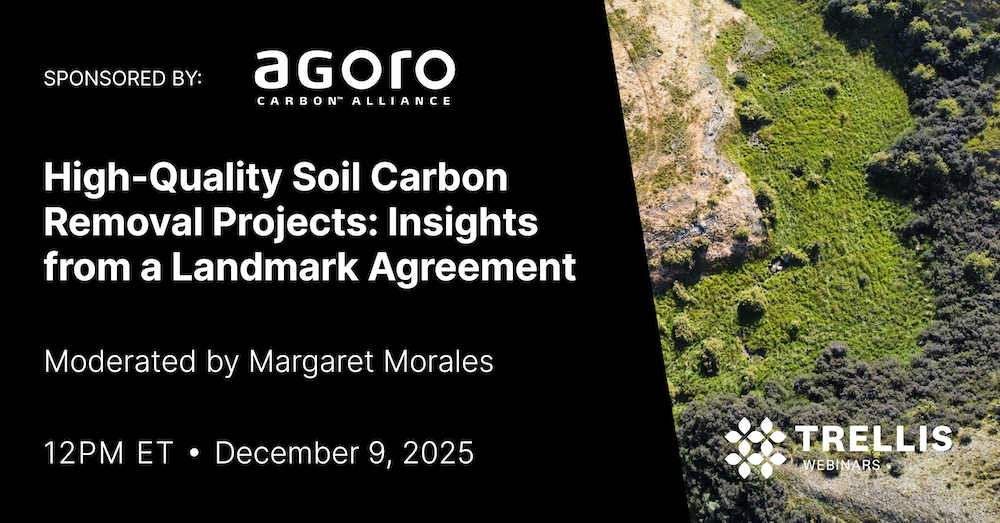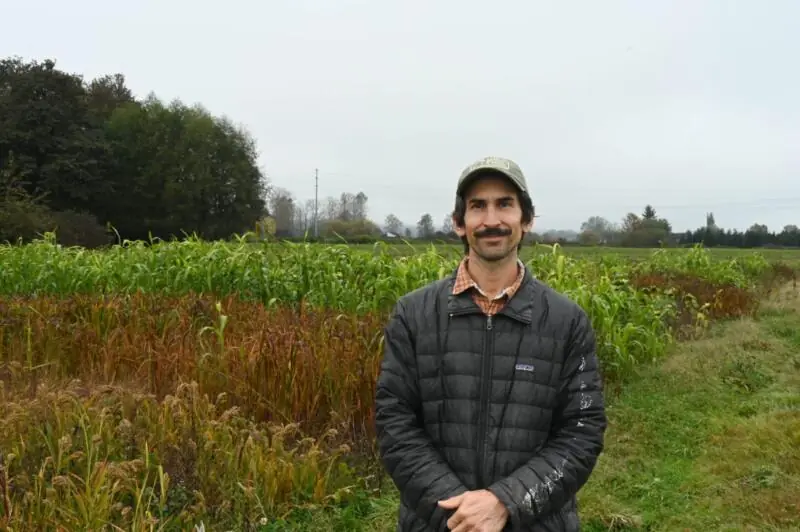High-Quality Soil Carbon Removal Projects | Webinar – Trellis Group

Report on a Strategic Partnership for Soil Carbon Sequestration and Sustainable Development Goals
Executive Summary
A landmark 12-year soil carbon removal agreement has been established between Agoro Carbon Alliance and Microsoft. This initiative represents one of the most significant long-term agreements in the voluntary carbon market, focusing on soil carbon as a nature-based solution to climate change. The partnership is designed to drive measurable environmental impact and establish new benchmarks for quality and scale, directly contributing to several United Nations Sustainable Development Goals (SDGs).
Alignment with SDG 13: Climate Action
The core objective of the agreement is to accelerate climate action through a scalable, high-integrity carbon removal pathway. By sequestering carbon in agricultural soils, the initiative directly supports the targets of SDG 13.
- It provides a tangible mechanism for large-scale carbon dioxide removal from the atmosphere.
- The long-term structure of the agreement ensures a sustained commitment to mitigating climate change over a 12-year period.
- It promotes the development of high-quality, verifiable carbon credits, strengthening the voluntary carbon market as a tool for climate finance.
Contribution to SDG 15: Life on Land and SDG 2: Zero Hunger
The project’s focus on soil health generates co-benefits that advance goals for terrestrial ecosystems and food security.
- SDG 15: Life on Land: Enhancing soil organic carbon improves soil structure, water retention, and biodiversity, contributing to the restoration of degraded land and strengthening terrestrial ecosystems.
- SDG 2: Zero Hunger: Healthier soils lead to more resilient and productive agricultural systems, supporting sustainable food production and enhancing food security for communities.
Fostering SDG 17: Partnerships for the Goals
The collaboration between Agoro Carbon Alliance and Microsoft exemplifies a cross-sectoral partnership essential for achieving the SDGs. It demonstrates a model for how corporate buyers, project suppliers, and other market participants can work together to scale climate solutions.
- The agreement serves as a blueprint for structuring public-private partnerships aimed at environmental stewardship.
- It encourages transparency and knowledge-sharing to build a more credible and effective carbon market.
- The initiative aims to foster a broader ecosystem of collaboration to accelerate the adoption of high-quality, nature-based solutions.
Key Strategic Objectives for Market Stakeholders
The partnership outlines a clear framework for advancing high-integrity soil carbon projects. Key objectives for stakeholders in the voluntary carbon market include:
- Project Evaluation: To develop methodologies for evaluating and selecting soil carbon projects that meet the highest quality standards, mitigate key risks, and unlock potential for scale, ensuring alignment with SDG 13 and SDG 15.
- Agreement Structuring: To provide practical guidance on structuring long-term carbon removal agreements that effectively balance quality assurance, financial performance (contributing to SDG 8: Decent Work and Economic Growth), and measurable climate impact.
- Scaling Solutions: To understand how leading corporations are scaling soil carbon removals through transparent, science-based partnerships, in line with the principles of SDG 17.
- Market Benchmarking: To analyze how the Agoro Carbon–Microsoft agreement sets a new benchmark for credibility and scale, driving greater ambition and integrity across the voluntary carbon market.
Analysis of Sustainable Development Goals in the Article
1. Which SDGs are addressed or connected to the issues highlighted in the article?
-
SDG 13: Climate Action
- The article’s central theme is “soil carbon removal” as a “nature-based pathway” to combat climate change. The partnership between Agoro Carbon Alliance and Microsoft is explicitly aimed at achieving a “climate impact” through the voluntary carbon market, directly aligning with the goal of taking urgent action to combat climate change.
-
SDG 15: Life on Land
- The methodology discussed, soil carbon sequestration, is directly related to land management. Enhancing soil carbon improves soil health, combats land degradation, and supports terrestrial ecosystems. The focus on “soil carbon projects” inherently connects to protecting and restoring life on land.
-
SDG 17: Partnerships for the Goals
- The article highlights a “landmark 12-year soil carbon removal agreement” between two private sector entities, Agoro Carbon Alliance and Microsoft. It emphasizes fostering “collaboration among buyers, suppliers, and other market participants” and creating “transparent, science-based partnerships,” which is the core principle of this SDG.
-
SDG 2: Zero Hunger
- Although not mentioned directly, soil carbon projects are intrinsically linked to agriculture. Practices that increase soil carbon also improve soil fertility, water retention, and resilience, which are fundamental to sustainable food production systems and ensuring long-term agricultural productivity.
2. What specific targets under those SDGs can be identified based on the article’s content?
-
Under SDG 13 (Climate Action):
- Target 13.2: Integrate climate change measures into national policies, strategies and planning. The article discusses a corporate-level strategy through the “voluntary carbon market” which is a significant measure contributing to overall climate action. The “long-term carbon removal agreements” represent a structured plan to mitigate climate change.
- Target 13.3: Improve education, awareness-raising and human and institutional capacity on climate change mitigation. The article is an announcement for a webinar designed to “share insights” and provide “practical guidance” on scaling carbon removal solutions, directly contributing to education and capacity-building for “buyers, suppliers, and other market participants.”
-
Under SDG 15 (Life on Land):
- Target 15.3: By 2030, combat desertification, restore degraded land and soil… and strive to achieve a land degradation-neutral world. The focus on “soil carbon projects” is a direct method to improve soil quality and restore land, contributing to this target.
-
Under SDG 17 (Partnerships for the Goals):
- Target 17.16: Enhance the global partnership for sustainable development, complemented by multi-stakeholder partnerships that mobilize and share knowledge, expertise, technology and financial resources. The Agoro-Microsoft agreement is a prime example of a private-sector partnership mobilizing financial resources (“long-term purchase agreements”) and sharing knowledge (via the webinar) to achieve a common goal.
- Target 17.17: Encourage and promote effective public, public-private and civil society partnerships. The article presents the Agoro-Microsoft agreement as a model that “sets a new benchmark for credibility and scale,” thereby promoting a framework for other effective partnerships in the voluntary carbon market.
-
Under SDG 2 (Zero Hunger):
- Target 2.4: By 2030, ensure sustainable food production systems and implement resilient agricultural practices that… progressively improve land and soil quality. The soil carbon projects discussed are a form of resilient agricultural practice that inherently improves soil quality, which is a foundation for sustainable food production.
3. Are there any indicators mentioned or implied in the article that can be used to measure progress towards the identified targets?
-
For SDG 13 (Climate Action):
- An implied indicator is the volume of carbon removed or sequestered through the agreements. The article mentions a “landmark 12-year soil carbon removal agreement” and the goal to “scale high-quality solutions,” indicating that the amount of carbon removed is a key performance metric.
-
For SDG 15 (Life on Land):
- An implied indicator is the area of land under management for soil carbon enhancement. The scale of the “soil carbon projects” is a direct measure of the land area being restored or managed sustainably.
-
For SDG 17 (Partnerships for the Goals):
- A clear indicator is the number and scale of multi-stakeholder partnerships formed. The article explicitly highlights the “Agoro Carbon–Microsoft agreement” and the intent to foster “collaboration among buyers, suppliers, and other market participants,” which can be tracked as a measure of progress.
-
For SDG 2 (Zero Hunger):
- An implied indicator is the improvement in soil quality on lands involved in the carbon projects. While the article focuses on carbon, measuring soil health metrics (like organic matter content) would be a direct indicator of progress towards this target.
4. Summary Table of SDGs, Targets, and Indicators
| SDGs | Targets | Indicators (Implied from Article) |
|---|---|---|
| SDG 13: Climate Action | 13.2: Integrate climate change measures into policies and planning. 13.3: Improve education and awareness on climate change mitigation. |
Volume of carbon removed through voluntary market agreements; Number of knowledge-sharing initiatives (e.g., webinars) among market participants. |
| SDG 15: Life on Land | 15.3: Combat desertification, restore degraded land and soil. | Area of land managed under soil carbon enhancement projects. |
| SDG 17: Partnerships for the Goals | 17.16 & 17.17: Enhance and promote multi-stakeholder partnerships for sustainable development. | Number and scale of long-term, science-based partnerships between private sector entities (buyers and suppliers). |
| SDG 2: Zero Hunger | 2.4: Ensure sustainable food production systems and resilient agricultural practices. | Adoption of agricultural practices that improve soil quality and carbon content. |
Source: trellis.net
What is Your Reaction?
 Like
0
Like
0
 Dislike
0
Dislike
0
 Love
0
Love
0
 Funny
0
Funny
0
 Angry
0
Angry
0
 Sad
0
Sad
0
 Wow
0
Wow
0















































/environment-climate-change-and-health-(ech)/water-sanitation-hygiene-and-health-(wsh)/landfill-tuvalu-36092.tmb-1200v.jpg?sfvrsn=5c21fe40_1#)


.jpg.webp?itok=0ZsAnae9#)

























